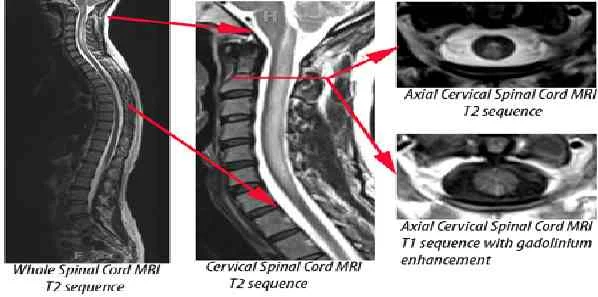A new chemical compound developed by a team of international scientists shows much potential in restoring function lost to spinal cord injury. The compound, which the team dubbed intracellular sigma peptide (ISP), allowed paralysed muscles to activate in more than 80 percent of the animals tested. The findings are published in the journal Nature.
Case Western Reserve University School of Medicine Professor of Neurosciences Jerry Silver, PhD, the senior author, led the team in the research in which 21 of 26 animals (rats) with spinal cord injury regained the ability to urinate, move or both. In the experiments, ISP appears to allow nerve fibres to overcome scarring that normally blocks their regrowth.
“This recovery is unprecedented,” Professor Silver noted. “Each of the 21 animals got something back in terms of function. For any spinal cord-injured patient today, it would be considered extraordinary to regain even one of these functions, especially bladder function. ISP additionally has treatment potential for diseases where the body produces destructive scarring such as heart attack, peripheral nerve injury and multiple sclerosis (MS).” Prof. Silver’s team now is testing the effectiveness of ISP in animal models of these disorders.
Following injury in the central nervous system, molecules known as proteoglycans collect in scar tissue at the injury site and in the perineuronal net. In healthy tissue, proteoglycans are key components in the matrix between cells and play an important role in maintaining the structure of the nervous system. However, following injury, proteoglycans are overly abundant in scar tissue and the impenetrable nets around synapses throughout the brain and spinal cord.
The consequence is a formidable barrier preventing regeneration and new nerve connections, the researchers explained. Proteoglycans produce a sticky quagmire, trapping and restricting the cut nerve fibre tips (called growth cones) from making their journey back to their proper synaptic connections. It is these connections that transmit critical information through electrical impulses to nerve cells that enable a person or animal to control bodily functions.
“There are currently no drug therapies available that improve the very limited natural recovery from spinal cord injuries that patients experience,” according to Lyn Jakeman, PhD, a programme director at the NIH’s National Institute of Neurological Disorders and Stroke in Bethesda, Maryland. “This is a great step toward identifying a novel agent for helping people recover.”
Prof. Silver and colleagues designed the ISP peptide to turn off the neuron’s proteoglycan receptor on/off switch. They added a shuttle called TAT (trans-activator of transcription) to deliver ISP throughout the nervous system and across cell membranes. ISP travels to and penetrates the membranes of cells, including the scar tissue-covered injury site. As the peptides can penetrate tissue, the researchers noted, ISP can be delivered systemically rather than with a direct injection to the spinal cord.
For this study, 26 severely spinal cord-injured rats received daily injections for seven weeks. During that time, the animals were assessed for their ability to walk, to balance and to control when and how much they urinate. The investigators observed that 21 of the 26 rats regained one or more of the functions well after injections began. Interestingly, some animals regained all three behaviours and others one or two out of three. As Prof. Silver pointed out: “We don’t know why a particular animal regained a specific function. That is one of the big remaining questions.”
One clue may be the small amounts of nerve tracts spared in the rats’ spinal cords. These remaining tracts are differentially damaged by bleeding or inflammation sustained immediately after the original injury. One particularly important tract that responded robustly to ISP contains serotonergic fibres, the research team said. These fibres release the neurotransmitter serotonin into the spinal cord which, in turn, boosts functional activity of the scant numbers of remaining fibre tracts that control the behaviours that were restored.
Each animal had different serotonergic sprouting patterns and variable tract sparing, which probably accounts for the different functions they were able to regain. According to Prof. Silver, “Sprouting is a critical phenomenon. Even if there are just a few intact fibres left after the injury, it could be one critical piece that brings back an important function.”
Bradley Lang, a graduate student in Prof. Silver's lab and the study's lead author, explained that the team's treatment strategy was designed to be easily translatable. “Our goal is to progress this treatment forward for use as a therapeutic following spinal cord injury.”
Source: Newswise.com
Image Credit: Google Images
Case Western Reserve University School of Medicine Professor of Neurosciences Jerry Silver, PhD, the senior author, led the team in the research in which 21 of 26 animals (rats) with spinal cord injury regained the ability to urinate, move or both. In the experiments, ISP appears to allow nerve fibres to overcome scarring that normally blocks their regrowth.
“This recovery is unprecedented,” Professor Silver noted. “Each of the 21 animals got something back in terms of function. For any spinal cord-injured patient today, it would be considered extraordinary to regain even one of these functions, especially bladder function. ISP additionally has treatment potential for diseases where the body produces destructive scarring such as heart attack, peripheral nerve injury and multiple sclerosis (MS).” Prof. Silver’s team now is testing the effectiveness of ISP in animal models of these disorders.
Following injury in the central nervous system, molecules known as proteoglycans collect in scar tissue at the injury site and in the perineuronal net. In healthy tissue, proteoglycans are key components in the matrix between cells and play an important role in maintaining the structure of the nervous system. However, following injury, proteoglycans are overly abundant in scar tissue and the impenetrable nets around synapses throughout the brain and spinal cord.
The consequence is a formidable barrier preventing regeneration and new nerve connections, the researchers explained. Proteoglycans produce a sticky quagmire, trapping and restricting the cut nerve fibre tips (called growth cones) from making their journey back to their proper synaptic connections. It is these connections that transmit critical information through electrical impulses to nerve cells that enable a person or animal to control bodily functions.
“There are currently no drug therapies available that improve the very limited natural recovery from spinal cord injuries that patients experience,” according to Lyn Jakeman, PhD, a programme director at the NIH’s National Institute of Neurological Disorders and Stroke in Bethesda, Maryland. “This is a great step toward identifying a novel agent for helping people recover.”
Prof. Silver and colleagues designed the ISP peptide to turn off the neuron’s proteoglycan receptor on/off switch. They added a shuttle called TAT (trans-activator of transcription) to deliver ISP throughout the nervous system and across cell membranes. ISP travels to and penetrates the membranes of cells, including the scar tissue-covered injury site. As the peptides can penetrate tissue, the researchers noted, ISP can be delivered systemically rather than with a direct injection to the spinal cord.
For this study, 26 severely spinal cord-injured rats received daily injections for seven weeks. During that time, the animals were assessed for their ability to walk, to balance and to control when and how much they urinate. The investigators observed that 21 of the 26 rats regained one or more of the functions well after injections began. Interestingly, some animals regained all three behaviours and others one or two out of three. As Prof. Silver pointed out: “We don’t know why a particular animal regained a specific function. That is one of the big remaining questions.”
One clue may be the small amounts of nerve tracts spared in the rats’ spinal cords. These remaining tracts are differentially damaged by bleeding or inflammation sustained immediately after the original injury. One particularly important tract that responded robustly to ISP contains serotonergic fibres, the research team said. These fibres release the neurotransmitter serotonin into the spinal cord which, in turn, boosts functional activity of the scant numbers of remaining fibre tracts that control the behaviours that were restored.
Each animal had different serotonergic sprouting patterns and variable tract sparing, which probably accounts for the different functions they were able to regain. According to Prof. Silver, “Sprouting is a critical phenomenon. Even if there are just a few intact fibres left after the injury, it could be one critical piece that brings back an important function.”
Bradley Lang, a graduate student in Prof. Silver's lab and the study's lead author, explained that the team's treatment strategy was designed to be easily translatable. “Our goal is to progress this treatment forward for use as a therapeutic following spinal cord injury.”
Source: Newswise.com
Image Credit: Google Images
Latest Articles
Brain, spinal cord injury, peptide, proteoglycans, nervous system
A new chemical compound developed by a team of international scientists shows much potential in restoring function lost to spinal cord injury. The compound...










